Our Prout Escale Catamaran Steering Repair
The steering systems on Prout Catamarans are typically actuated via hydraulic rams. Our system consisted of a Teleflex Seastar BA 150 x 7 ATM ram placed in the starboard hull, along with a rotary encoder for the Autohelm ST7000 autopilot. A large Aluminum cross-bar runs across the width of the hull to the other side, ensuring that the rudders always point in the same direction.
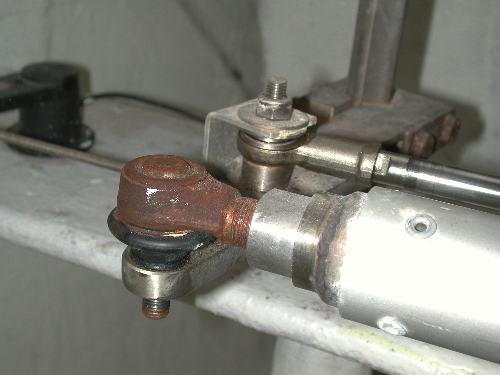
In the picture above, you can see how the two stainless rudderstock is mechanically fastened to levers which connect to the cross-beam via simple tie-rods screwed into the cross-beam. The stainless hardware in the background is the hydraulic ram. To the left, you can see the black rotary encoder.
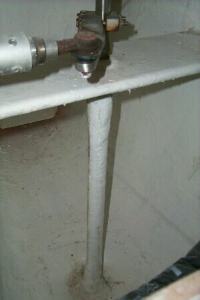 Here is a picture from the other hull showing the rudderstock and the plank that holds its top in place. This inexpensive composite construction technique is a clever means of ensuring that the rudderstock is held in place. Even better, there is no reason to install expensive seals as the top of the tube is always above sea level.
Here is a picture from the other hull showing the rudderstock and the plank that holds its top in place. This inexpensive composite construction technique is a clever means of ensuring that the rudderstock is held in place. Even better, there is no reason to install expensive seals as the top of the tube is always above sea level.
Note the rust on the tie-rod as well as the stainless components. This shows ample evidence of the water problems that used to plague this compartment. Stainless isn't supposed to rust, but here it did.
I have already drawn up contingency plans to replace the components in the future. As I see it, the tie-rod is the weakest component in this assembly, as its bolt works against the shearing forces exerted by the lever coming out of the rudder-stock. My plan is to substitute a tie-rod that does not feature a internal bolt. Instead, the tie-rod would be surrounded on both sides by the lever and a smooth pin would connect the two. A large bearing surface ensures strength!
The next weakest link is the connection between the rudder-stock and the lever on it. Here, the rotation of the rudder works against two weakened staineless bolts. This system is probably the result of the rather uneven rudder stock... A system using a wedge with a screw-drive would work better.
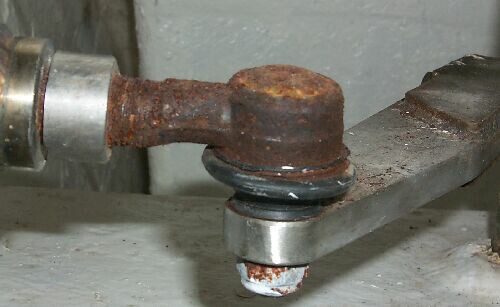
Here is a close-up of one of the the steering ball joints. As you can see, they are completely covered in rust. Luckily, an inspection of the works inside them revealed that internals of the joints are fine. I greased up the whole assembly to prevent further oxidation and will leave it for now.
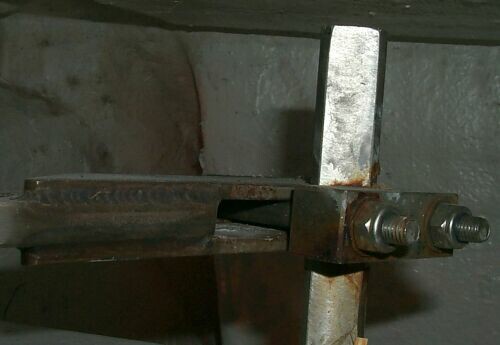
Just two bolts in tension are holding that rudderstock to its lever...
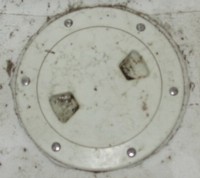 Here is a picture of the inspection ports that Prout installed over the rudder assembly. In theory, they allow the boat to be fitted with an emergency rudder should the hydraulics fail or bind.
Here is a picture of the inspection ports that Prout installed over the rudder assembly. In theory, they allow the boat to be fitted with an emergency rudder should the hydraulics fail or bind.
Unfortunately, these allegedly "waterproof" inspection ports were installed on steps that are typically covered with water whenever we do not have the dinghy in its davits. Until we replaced them with a pair of inspection ports that were actually waterproof (and sealing them to the hull with a real sealant, not silicone), the steering system was repeatedly drenched with brackish water.
The old furnace was a casualty of the waterfall through the heater hatch before we fixed the hatch drainage.
Best Estimate of Time Spent Fixing Companionway Defects:
| Determine size of joint, order replacement | TBD |
|---|---|
| Extract ball joint, install replacement | TBD |
| Inspect other parts of rudder while we're at it | TBD |
| Total | TBD |
|---|


